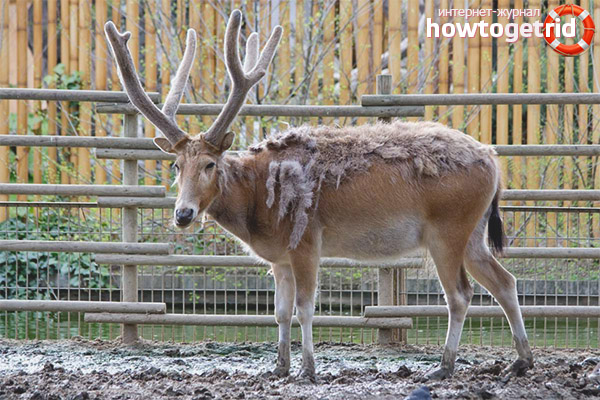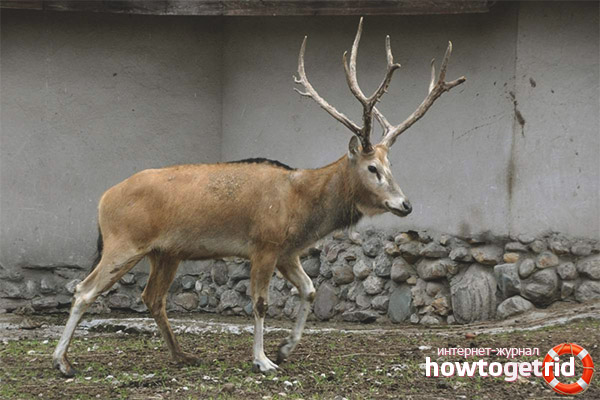The content of the article
David's deer is a rather rare animal, the existence of which the European part of the population did not even suspect until the beginning of the nineteenth century. The discovery of a new species was made by a missionary - Lazarist from France Arman David, who studies botany and zoology. This scientist first encountered an unusual deer during his trip to China. He saw a representative of an unknown species in the closed garden of the emperor. In this area, Arman David discovered the skeleton of adult individuals of both sexes, as well as the remains of the cub. The scientist sent the materials to Paris in order to further compile a description of the species. Subsequently, the animal got its name - the deer of David.
According to scientists, at the time of detection of skeletons of individuals, animals of this species either already ceased to exist in nature, or remained in a very small amount. You can also sometimes find information that the last representative of David's deer was shot dead near the Yellow Sea in 1939. There is no evidence of this fact, and therefore it is impossible to assert with certainty that this was exactly so. Even if at that time the deer of David was still living in nature, the number of individuals was relatively small.
In history, the fact is known that in 1869, the Emperor of China Tongzhi presented several deers of Great Britain, France and Germany for keeping in zoos. However, individuals survived only in the UK. After this friendly gesture in China, a severe flooding occurred as a result of the Yellow River spill. A large number of individuals simply died in such conditions. The remainder of the deer was destroyed later in 1900 during a boxing rebellion. It is for this reason that all of David's deer existing today can be considered the descendants of precisely those individuals who managed to survive in the UK zoo. Over time, representatives of the species began to be bred in captivity, thanks to which David's deer appeared in zoos around the world.
The main reasons for the sharp decline in the number of individuals in natural conditions was the uncontrolled destruction of animals during the hunt, as well as the destruction of deer habitat. Currently, there are several hundred animals of this species in the world, kept in various zoos. In addition, a rather large group of individuals was transported to the Dafin Milu Nature Reserve back in 1985.
Scientists suggest that these territories were the ancestral home of David's deer. In this area, the animals feel pretty good, the process of reproduction is actively going on. At the moment, about two thousand individuals already live in the reserve. For this reason, in the near future, it is possible that animals will begin a new life in the wild.
In what territories does it live?
Today, David's deer are found only in zoos and nature reserves. Previously, they populated the north-eastern parts of China. For living animals chose flat terrain located not far from swamps or ponds. As a rule, David’s deer were characterized by seasonal transitions from one locality to another, in most cases they were migrations to river valleys.
What does a deer of David look like?
It is worth noting that the deer of David has not only an unusual history of its origin, but also a rather strange appearance. In size, the animal is quite large. The length of the body of a deer reaches two meters, with a maximum height of 1.1 meters. The mass of the animal can vary from 130 to 200 kilograms.
David's deer has a rather large and somewhat elongated head, on which large eyes with pronounced glands in front of them can be noted. Large and beautiful horns can be found only in representatives of the strong half. As a rule, males change them up to two times a year. The tail has a length of up to half a meter, at the end is a black tassel. The color of deer can be different. It depends mainly on the time of year. In the summer months, wool usually has a tan hue, but in winter it becomes gray.
A distinctive feature of David's deer is the presence throughout the year of rather long outer hair, which, moreover, also curls. On the back, in the area of the spine, namely along it, you can see a dark strip.
Representatives of this species have long legs with wide hooves and a rather extensive stable calcaneal part. These legs and hooves are designed for walking in marshland, as well as soft soil.
Description of the appearance of the deer David has a lot of interesting features. It is curious that in China this animal had a completely different name. The Chinese called these individuals "similar to four." The fact is that David's deer have hooves, like that of cows, a tail that closely resembles a donkey’s tail, a rather long and weighty neck, like a camel’s, as well as the horns of a real deer.
Lifestyle
The amazing fact is that David's deer are extremely fond of water and love to be in it. Unlike most of its brethren, this species of deer even knows how to swim. Individuals can easily spend most of the day in a pond, moreover, they enter the water almost completely, leaving only their heads on the surface.
Breeding

Deer of David become sexually mature at the age of two years. Their mating season is quite interesting. Males in the fight for females arrange real fights, using not only horns, but also teeth, and even hooves. At the same time, one male can collect several females around him at once, arranging a kind of harem. The female carries the calf for about 9-10 months. Most often, one deer is born. In rare cases, childbirth can bring two babies at once. When kept in an enclosure, many females, in principle, cannot bear more than two or three cubs throughout their life. A female is engaged in feeding the deer, which for 11 months feeds the baby with milk, and then begins to gradually introduce the usual adult food.
What do the deer of David eat?
Today it is reliably known that the only enemies of this species of deer in natural conditions were tigers, as well as leopards. Individuals currently living in captivity, of course, do not meet their enemies. However, it is worth noting that even the usual image of these predators can cause deer to panic. On average, David's deer live for about 18 years.
Thanks to Armand David, it was possible to save so many unusual species of deer from extinction. It is through his work today that we can observe individuals in zoos and nature reserves.
Video: David deer (Elaphurus davidianus)











Submit